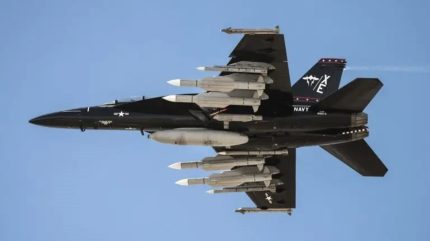
Lockheed Martin‘s advanced infrared search-and-track (IRST) system has reached initial operating capability (IOC) on the US Navy F/A-18 Super Hornet aircraft.
This new system, named IRST21, is a long-wave infrared search-and-track sensor that allows for the passive detection of airborne threats at extended ranges, far surpassing visual capabilities.
The IOC status marks a step towards full-rate production, following a series of successful flight evaluations conducted by the Navy.
Lockheed Martin IRST programmes director Paul Hey said: “Achieving IOC for IRST21 is a significant milestone and a testament to the strong partnership between Lockheed Martin and the US Navy.
“This advanced sensor provides a critical capability to detect and track airborne threats at greater distances, ensuring pilots can complete their missions with enhanced situational awareness and survivability.”
The F/A-18E/F Super Hornet began service in 1999 as a successor to the F-14 Tomcat. The single-seat (F/A-18E) and two-seat (F/A-18F) variants are replacing older models as they reach the end of their operational lifespan.
How well do you really know your competitors?
Access the most comprehensive Company Profiles on the market, powered by GlobalData. Save hours of research. Gain competitive edge.

Thank you!
Your download email will arrive shortly
Not ready to buy yet? Download a free sample
We are confident about the unique quality of our Company Profiles. However, we want you to make the most beneficial decision for your business, so we offer a free sample that you can download by submitting the below form
By GlobalDataAccording to Lockheed Martin, IRST21 will ensure the Navy’s current fleet of F/A-18s remains effective in the context of fifth-generation warfare.
The integration of the IRST21 system extends the threat detection capabilities of the Navy’s Super Hornets. The system features an open-architecture design.
Mounted at the front of the centreline fuel tank, the IRST21 system seamlessly blends with the aircraft’s design, notes the company.
The company also noted that IRST21’s threat data can be integrated with information from other sensors and distributed throughout the battlespace, enhancing support for Joint All-Domain Operations (JADO).
Lockheed Martin Sensors & Global Sustainment organisation Mission Systems vice-president Hank Tucker said: “With this game-changing leap in passive sensing technology, IRST21 will fundamentally reshape how air warfare is conducted while keeping pilots ahead of threats.
“We’re proud to enhance the Super Hornet with an advanced sensor system that ensures strategic superiority in evolving threat environments.”
The IRST21 sensor system has demonstrated its reliability across more than 300,000 flight hours on different platforms, with 505 units delivered to the Navy, US Air Force, and other branches by 1 April 2022.



